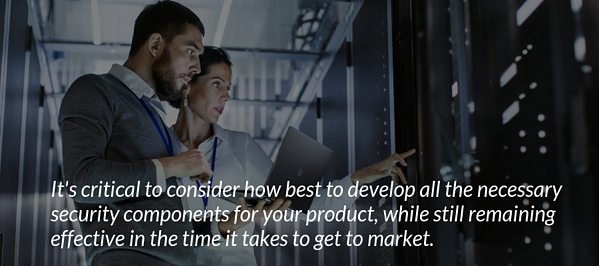When it comes to security in product development, there is a lot to consider, especially now that everything from vehicles to appliances are connected to the internet. Although this connectivity is highly desirable and lucrative in the market, it also opens the door to a slew of security threats. Companies that previously have not had to consider security from a technological standpoint are now creating devices that have IoT capabilities, and this inexperience leads to vulnerabilities that could have dire consequences. In fact, it is a common belief that the most innocuous devices are the ones that are most likely to be hacked and used to obtain sensitive information.
When you couple lack of experience with the desire to get new devices to market quickly, it becomes clear why security is often a low priority. In the long run, this attitude can greatly impact companies from a revenue standpoint. According to Security Today, “the average cost, globally, for each lost or stolen record containing sensitive and confidential information is… $148 per record. A 4.8 percent increase from 2017.” Multiply that cost by thousands of users, and the potential loss of revenue is easy to imagine. In order to combat costly mistakes, it’s important to pay attention to existing risks and consider how those risks might evolve in the future. It’s critical to consider how best to develop all the necessary security components for your product, while still remaining effective in the time it takes to get to market. Here are some aspects to keep in mind when pondering these crucial aspects of technological development.
Planning your development process
In order to ensure that security is a top priority, your organization should answer the following questions with a security-first mindset before embarking on any new project. This way, you are not reactively attempting to fix costly mistakes should something go wrong.
- How is this device going to be used today and in the future?
- Who is utilizing the device on a day-to-day basis?
- What kind of access do these users have?
- What type of system will you use? Android? IOS?
- What development languages will you use?
- What process will you implement to ensure security is built in from the start?
Thorough planning and risk assessment can reduce the number of errors that are made and ensure that you are creating a secure, effective product.
Once you have formulated a plan and considered all aspects of security, create benchmarks so you can determine whether your implementations are successful. Build in the ability to quickly revise code or release an update to your software in the event something happens. Additionally, ensure that you have an effective way to reach your customers — updates are useless if your users are unaware of crucial information that impacts their security.

Consider short and long-term needs
Even after all the relevant considerations are made and your product has been successfully delivered, you cannot become complacent. It is important to maintain these processes. You may have the best technology out on the market, but if you don’t have strategic processes in place to monitor and make adjustments, it will be unsuccessful. It is also helpful to remember that the best technology on the market today will not be the best 12 months from now, so your organization needs to be able to adapt and change over time.
Another proactive approach to take is to employ “white-hat” hackers to test your systems and search for vulnerabilities. Through a controlled approach, send phishing emails to your employees and analyze the results. Once such vulnerabilities are identified and addressed, you’ll be able to adjust accordingly and avoid potential security breaches. A proactive approach for security in product development is key.
Get help
With the various considerations and moving parts involved in developing security best practices into product development, it is worth contemplating the addition of security experts to your current team. That way, you’ll be able to continue focusing on your areas of expertise, while those professionals you have added to your team will help you consider what is necessary to create a secure, successful product. However, the search for in-demand security specialists who can create core competencies and best practices for you is an arduous task, and it can be time consuming to establish subject matter experts in this field. That’s why it is beneficial to rely upon a partner who has access to individuals with experience completing development projects while maintaining security best practices every step of the way. Working with a staffing and consulting company can be an excellent way to save time and resources, and ultimately improve your security throughout the product build.
Although implementing and developing new technological products can be an involved endeavor, it is worthwhile to be thorough and consider every aspect, including security, from the start. Otherwise, security issues could end up costing your organization more than just revenue — you could lose the trust of your customer base.

.svg.png)

